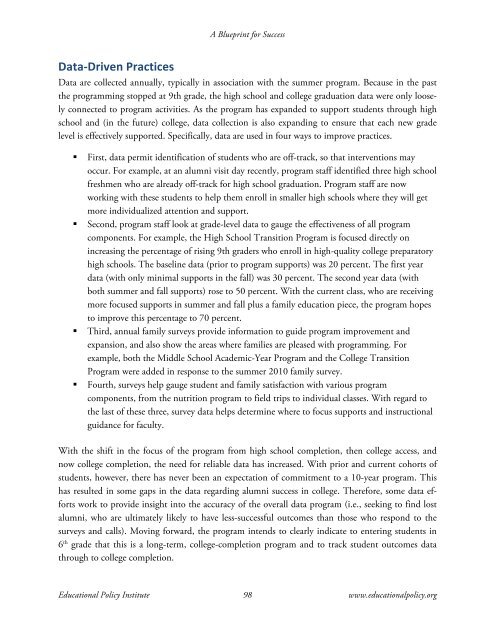A BluePrint for Success: Case Studies of Successful - Educational ...
A BluePrint for Success: Case Studies of Successful - Educational ...
A BluePrint for Success: Case Studies of Successful - Educational ...
You also want an ePaper? Increase the reach of your titles
YUMPU automatically turns print PDFs into web optimized ePapers that Google loves.
Data-‐Driven Practices<br />
A Blueprint <strong>for</strong> <strong>Success</strong><br />
Data are collected annually, typically in association with the summer program. Because in the past<br />
the programming stopped at 9th grade, the high school and college graduation data were only loosely<br />
connected to program activities. As the program has expanded to support students through high<br />
school and (in the future) college, data collection is also expanding to ensure that each new grade<br />
level is effectively supported. Specifically, data are used in four ways to improve practices.<br />
First, data permit identification <strong>of</strong> students who are <strong>of</strong>f-track, so that interventions may<br />
occur. For example, at an alumni visit day recently, program staff identified three high school<br />
freshmen who are already <strong>of</strong>f-track <strong>for</strong> high school graduation. Program staff are now<br />
working with these students to help them enroll in smaller high schools where they will get<br />
more individualized attention and support.<br />
Second, program staff look at grade-level data to gauge the effectiveness <strong>of</strong> all program<br />
components. For example, the High School Transition Program is focused directly on<br />
increasing the percentage <strong>of</strong> rising 9th graders who enroll in high-quality college preparatory<br />
high schools. The baseline data (prior to program supports) was 20 percent. The first year<br />
data (with only minimal supports in the fall) was 30 percent. The second year data (with<br />
both summer and fall supports) rose to 50 percent. With the current class, who are receiving<br />
more focused supports in summer and fall plus a family education piece, the program hopes<br />
to improve this percentage to 70 percent.<br />
Third, annual family surveys provide in<strong>for</strong>mation to guide program improvement and<br />
expansion, and also show the areas where families are pleased with programming. For<br />
example, both the Middle School Academic-Year Program and the College Transition<br />
Program were added in response to the summer 2010 family survey.<br />
Fourth, surveys help gauge student and family satisfaction with various program<br />
components, from the nutrition program to field trips to individual classes. With regard to<br />
the last <strong>of</strong> these three, survey data helps determine where to focus supports and instructional<br />
guidance <strong>for</strong> faculty.<br />
With the shift in the focus <strong>of</strong> the program from high school completion, then college access, and<br />
now college completion, the need <strong>for</strong> reliable data has increased. With prior and current cohorts <strong>of</strong><br />
students, however, there has never been an expectation <strong>of</strong> commitment to a 10-year program. This<br />
has resulted in some gaps in the data regarding alumni success in college. There<strong>for</strong>e, some data ef<strong>for</strong>ts<br />
work to provide insight into the accuracy <strong>of</strong> the overall data program (i.e., seeking to find lost<br />
alumni, who are ultimately likely to have less-successful outcomes than those who respond to the<br />
surveys and calls). Moving <strong>for</strong>ward, the program intends to clearly indicate to entering students in<br />
6 th grade that this is a long-term, college-completion program and to track student outcomes data<br />
through to college completion.<br />
<strong>Educational</strong> Policy Institute 98 www.educationalpolicy.org




